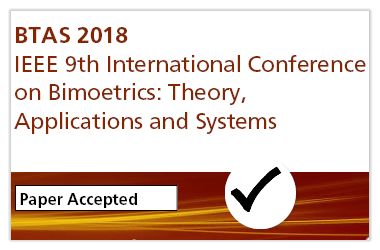Aktuelle
Meldungen
BTAS 2018
CRISP-Wissenschaftler des Fraunhofer IGD veröffentlichen Paper
Wissenschaftler des Fraunhofer IGD haben zwei Paper auf der IEEE International Conference on Biometrics: Theory, Applications, and Systems (BTAS) platziert. BTAS 2018 bietet ein Forum für WissenschaftlerInnen aus der ganzen Welt, um ihre neuesten Forschungsergebnisse vorzustellen und neue Ideen und Anwendungen in der Biometrie-Technologie auszutauschen. Erkenntnisse aus der auf Stimme, Fingerabdruck, Iris, Gesicht, Handschrift, Gangart und anderen Modalitäten basierenden Biometrie-Forschung sowie aktuelle Forschungsergebnisse, die auf neuartigen Sensortechnologien aufbauen, sind Themenschwerpunkte der Konferenz, die auch als Flaggschiff-Konferenz des IEEE Biometrics Council bezeichnet wird.
CRISP-Wissenschaftler Prof. Christoph Busch, Hochschule Darmstadt, ist Mitglied des Organisations-Komitees.

Die aktzeptieren Paper sind:
CrazyFaces: Unassisted Circumvention of Watchlist Face Identification
Autoren: Naser Damer, Yaza Wainakh, Viola Boller, Sven von den Berken, Philipp Terhörst, Andreas Braun, Arjan Kuijper
Abstract
Once upon a time, there was a blacklisted criminal who usually avoided appearing in public. He was surfing the Web, when he noticed, what had to be a targeted advertisement announcing a concert of his favorite band. The concert was in a near town, and the only way to get there was by train. He was worried, because he heard in the news about the new face identification system installed at the train station. From his last stay with the police, he remembers that they took these special face images with the white background. He thought about what can he do to avoid being identified and an idea popped in his mind ``what if I can make a crazy-face, as the kids call it, to make my face look different? What do I exactly have to do? And will it work?". He called his childhood geeky friend and asked him if he can build him a face recognition application he can tinker with. The geeky friend was always interested in such small projects where he can use open-source resources and didn't really care about the goal, as usual. The criminal tested the application and played around, trying to figure out how can he make a crazy-face that won't be identified as himself. On the day of the concert, he took off to the train station with some doubt in his mind and fear in his soul. To know what happened next, you should read the rest of this paper.
MorGAN: Recognition Vulnerability and Attack Detectability of Face Morphing Attacks Created by Generative Adversarial Network
Autoren: Naser Damer, Alexandra Moseguí Saladié, Andreas Braun, Arjan Kuijper
Abstract
Face morphing attacks aim at creating face images that are verifiable to be the face of multiple identities, which can lead to building faulty identity links in operations like border crossing. Research has been focused on creating more accurate attack detection approaches by considering different image properties. However, all the attacks considered so far are based on manipulating facial landmarks localized in the morphed face images. In contrast, this work presents novel face morphing attacks based on image generated by generative adversarial networks. We present the MorGAN structure that considers the representation loss to successfully create realistic morphing attacks. Based on that, we present a novel face morphing attacks database (MorGAN database) that contains 1000 morph images for both, the proposed MorGAN and landmark-based attacks. We present vulnerability analysis of two face recognition approaches facing the proposed attacks. Moreover, the detectability of the proposed MorGAN attacks is studied, in the scenarios where this type of attacks is know and unknown. We concluded with pointing out the challenge of detecting such unknown novel attacks and an analysis of detection performances of different features in detecting such attacks.
BTAS 2018 findet vom 22. - 25. Oktober 2018 in Los Angeles, USA statt.
Zur News-Übersicht
